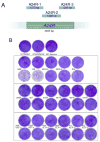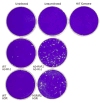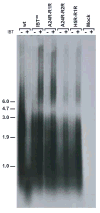A targeted approach to identification of vaccinia virus postreplicative transcription elongation factors: genetic evidence for a role of the H5R gene in vaccinia transcription
- PMID: 17376501
- PMCID: PMC1950266
- DOI: 10.1016/j.virol.2007.02.016
A targeted approach to identification of vaccinia virus postreplicative transcription elongation factors: genetic evidence for a role of the H5R gene in vaccinia transcription
Abstract
Treatment of wild-type vaccinia virus infected cells with the anti-poxviral drug isatin-beta-thiosemicarbazone (IBT) induces the viral postreplicative transcription apparatus to synthesize longer-than-normal mRNAs through an unknown mechanism. Prior studies have shown that virus mutants resistant to or dependent on IBT affect proteins involved in control of viral postreplicative transcription elongation, including G2, J3, and the viral RNA polymerase. Prior studies also suggest that there exist additional unidentified vaccinia genes that influence transcription elongation. The present study was undertaken to target candidate transcription elongation factor genes in an error-prone mutagenesis protocol to determine whether IBT-resistant or -dependent alleles could be isolated in those candidate genes. Mutagenesis of genes in which IBT resistance alleles have previously been isolated, namely A24R (encoding the second largest RNA polymerase subunit, rpo132) and G2R (encoding a positive transcription elongation factor), resulted in isolation of novel IBT resistance and dependence alleles therefore providing proof of principle of the targeted mutagenesis technique. The vaccinia H5 protein has been implicated previously in transcription elongation by virtue of its association with the positive elongation factor G2. Mutagenesis of the vaccinia H5R gene resulted in a novel H5R IBT resistance allele, strongly suggesting that H5 is a positive transcription elongation factor.
Figures






Similar articles
-
Mapping and phenotypic analysis of spontaneous isatin-beta-thiosemicarbazone resistant mutants of vaccinia virus.Virology. 2007 Jul 5;363(2):319-32. doi: 10.1016/j.virol.2007.02.005. Epub 2007 Mar 1. Virology. 2007. PMID: 17336362 Free PMC article.
-
The vaccinia virus bifunctional gene J3 (nucleoside-2'-O-)-methyltransferase and poly(A) polymerase stimulatory factor is implicated as a positive transcription elongation factor by two genetic approaches.Virology. 2000 Apr 10;269(2):345-55. doi: 10.1006/viro.2000.0243. Virology. 2000. PMID: 10753713
-
An isatin-beta-thiosemicarbazone-resistant vaccinia virus containing a mutation in the second largest subunit of the viral RNA polymerase is defective in transcription elongation.J Biol Chem. 2004 Oct 22;279(43):44858-71. doi: 10.1074/jbc.M408167200. Epub 2004 Aug 3. J Biol Chem. 2004. PMID: 15294890
-
Regulation of viral transcription elongation and termination during vaccinia virus infection.Biochim Biophys Acta. 2002 Sep 13;1577(2):325-36. doi: 10.1016/s0167-4781(02)00461-x. Biochim Biophys Acta. 2002. PMID: 12213661 Review.
-
Vaccinia virus transcription.J Gen Virol. 2003 Sep;84(Pt 9):2293-2303. doi: 10.1099/vir.0.18942-0. J Gen Virol. 2003. PMID: 12917449 Review.
Cited by
-
Monkeypox virus induces the synthesis of less dsRNA than vaccinia virus, and is more resistant to the anti-poxvirus drug, IBT, than vaccinia virus.Virology. 2016 Oct;497:125-135. doi: 10.1016/j.virol.2016.07.016. Epub 2016 Jul 26. Virology. 2016. PMID: 27467578 Free PMC article.
-
Genetic Confirmation that the H5 Protein Is Required for Vaccinia Virus DNA Replication.J Virol. 2015 Jun;89(12):6312-27. doi: 10.1128/JVI.00445-15. Epub 2015 Apr 8. J Virol. 2015. PMID: 25855734 Free PMC article.
-
Vaccinia Virus Attenuation by Codon Deoptimization of the A24R Gene for Vaccine Development.Microbiol Spectr. 2022 Jun 29;10(3):e0027222. doi: 10.1128/spectrum.00272-22. Epub 2022 May 18. Microbiol Spectr. 2022. PMID: 35583360 Free PMC article.
-
Exploring the genomic basis of Mpox virus-host transmission and pathogenesis.mSphere. 2024 Dec 19;9(12):e0057624. doi: 10.1128/msphere.00576-24. Epub 2024 Nov 14. mSphere. 2024. PMID: 39540739 Free PMC article. Review.
-
Ectromelia virus accumulates less double-stranded RNA compared to vaccinia virus in BS-C-1 cells.Virology. 2017 Sep;509:98-111. doi: 10.1016/j.virol.2017.06.010. Virology. 2017. PMID: 28628829 Free PMC article.
References
-
- Bayliss CD, Condit RC. Temperature-sensitive mutants in the vaccinia virus A18R gene increase double-stranded RNA synthesis as a result of aberrant viral transcription. Virology. 1993;194:254–262. - PubMed
-
- Beaud G, Beaud R. Preferential virosomal location of underphosphorylated H5R protein synthesized in vaccinia virus-infected cells. J Gen Virol. 1997;78(Pt 12):3297–3302. - PubMed
-
- Beaud G, Beaud R. Temperature-dependent phosphorylation state of the H5R protein synthesised at the early stage of infection in cells infected with vaccinia virus ts mutants of the B1R and F10L protein kinases. Intervirology. 2000;43:67–70. - PubMed
Publication types
MeSH terms
Substances
Grants and funding
LinkOut - more resources
Full Text Sources

